Exploring Spatial Accessibility to Urban Activities Based on the Transit-Oriented Development Concept in Pathum Thani, Thailand
Abstract
1. Introduction
2. Literature Review
2.1. Transit-Oriented Development (TOD) and Its Implication
2.2. Urban Activity and Opportunity to Quality of Life
3. Methodology
3.1. Study Area
3.2. Data Collection
3.3. Data Analysis
- (1)
- The first step involved considering and defining the network buffer of the study according to the concept of TOD that was expected to enhance accessibility and mobility within a specified buffer zone around transit areas such as public transport stations that were not restricted solely to rail mass transit stations, but also included bus stations, bus rapid transit, train stations, and others. In this research, the network buffer area was delineated from the locations of transit points, encompassing both rail mass transit and bus stops. The network buffer zone could be segmented into three distinct distances of 500 m, 1000 m, and 2000 m. These buffer sizes aligned with acceptable walking distances, as referenced in Zhang et al., where a 1 km buffer represents a 15 min walking distance [33]. While various studies have determined different buffer distances, they typically fall within the range of 300–1000 m or more [6,22,23]. In this phase, GIS-based network analysis techniques were employed to determine the reach distance to transit points based on the network buffer.
- (2)
- The second step involved considering the concentration of land use activities using the Getis-Ord Gi* Hotspot Analysis technique applied to urban land use within the specified network buffer zones around transit areas, serving as the TOD measurement. The Getis-Ord Gi* Hotspot Analysis method is utilized to detect spatial clustering effects and assess the distribution and association of urban land use within a given urban area based on geographical space. This analytical tool not only visualizes data distribution, but also facilitates the identification of areas with concentrated urban land use by evaluating both high and low values, with the Getis-Ord G* statistic representing a modification of the Gi statistic. When Gi > 0, it indicates that a region is surrounded by areas with high values, known as hotspots, signifying denser clusters. Conversely, when Gi < 0, it suggests that a region is surrounded by areas with low values, referred to as cold spots, indicating less dense clusters.
- (3)
- The third step involved considering the spatial relationship of internal accessibility within the network buffer zone around transit areas, serving as TOD measurement units, in conjunction with urban land use. This step aimed to evaluate the potential for enhancing access to utilization activities within the service area of the transportation system. The findings from this analysis will contribute to recommendations for applying the TOD concept to aid in the development of the mass transit system within the suburban area.
4. Results
4.1. Accessibility within Transit-Oriented Development (TOD)
4.2. Hotspot of Urban Activity within Transit-Oriented Development (TOD)
4.3. The Relationship between Distance within Network Buffer Zone and Urban Land Use Concentration
5. Discussion
6. Conclusions
Author Contributions
Funding
Institutional Review Board Statement
Informed Consent Statement
Data Availability Statement
Acknowledgments
Conflicts of Interest
References
- Iamtrakul, P.; Zhang, J. Measuring Pedestrians’ Satisfaction of Urban Environment Under Transit Oriented Development (TOD): A Case Study Of Bangkok Metropolitan, Thailand. Lowl. Technol. Int. 2014, 16, 125–134. [Google Scholar] [CrossRef]
- Papagiannakis, A.; Yiannakou, A. Do Citizens Understand the Benefits of Transit-Oriented Development? Exploring and Modeling Community Perceptions of a Metro Line under Construction in Thessaloniki, Greece. Sustainability 2022, 14, 7043. [Google Scholar] [CrossRef]
- Office of Transport and Traffic Policy and Planning. A Study on Transit Oriented Development in Thailand. 2021. Available online: https://www.otp.go.th/uploads/tiny_uploads/PDF/2565-05/25650510-Exsum%20Master%20Plan.pdf (accessed on 31 October 2023).
- Abdullah, J.; Mazlan, M.H. Characteristics of and Quality of Life in a Transit Oriented Development (TOD) of Bandar Sri Permaisuri, Kuala Lumpur. Procedia Soc. Behav. Sci. 2016, 234, 498–505. [Google Scholar] [CrossRef][Green Version]
- Din, B.; Manaf, H.A.; Sabar, R.; Anuar, N.K.; Osman, A.A. Assessing the imact of transit–oriented development on residents’ quality of life in northern malaysia. Plan. Malays. 2023, 21, 150–170. [Google Scholar] [CrossRef]
- Pan, H.; Li, J.; Shen, Q.; Shi, C. What determines rail transit passenger volume? Implications for transit oriented development planning. Transp. Res. D Transp. Environ. 2017, 57, 52–63. [Google Scholar] [CrossRef]
- Chan, N.W.; Nakamura, A.; Imura, H.; Ao, M. (Eds.) Transit Oriented Development. In Sustainable Urban Development; Water Watch Penang & Yokohama City University: Yokohama, Japan, 2016. [Google Scholar]
- Padon, A.; Iamtrakul, P. Land Use and Transport Integration to Promote Pedestrian Accessibility in the Proximity of Mass Transit Stations. In Proceedings of the 6th Thailand Rail Academic Symposium, Bangkok, Thailand, 21–22 November 2019. [Google Scholar]
- Deng, X.; Zhang, J.; Liao, S.; Zhong, C.; Gao, F.; Teng, L. Interactive Impacts of Built Environment Factors on Metro Ridership Using GeoDetector: From the Perspective of TOD. ISPRS Int. J. Geo-Inf. 2022, 11, 623. [Google Scholar] [CrossRef]
- Gutiérrez, J.; Cardozo, O.D.; García-Palomares, J.C. Transit Ridership Forecasting at Station Level: An Approach Based on Distance-Decay Weighted Regression. J. Transp. Geogr. 2011, 19, 1081–1092. [Google Scholar] [CrossRef]
- Nasri, A.; Zhang, L. The analysis of transit-oriented development (TOD) in Washington, D.C. and Baltimore metropolitan areas. Transp. Policy 2014, 32, 172–179. [Google Scholar] [CrossRef]
- Liu, Y.; Nath, N.; Murayama, A.; Manabe, R. Transit-oriented development with urban sprawl? Four phases of urban growth and policy intervention in Tokyo. Land Use Policy 2022, 112, 105854. [Google Scholar] [CrossRef]
- Ewing, R.; Meakins, G.; Hamidi, S.; Nelson, A.C. Relationship between urban sprawl and physical activity, obesity, and morbidity—Update and refinement. Health Place 2014, 26, 118–126. [Google Scholar] [CrossRef]
- Rahman, M.; Yasmin, S.; Eluru, N. Evaluating the Impact of A Newly Added Commuter Rail System on Bus Ridership: A Grouped Ordered Logit Model Approach. Transp. A Transp. Sci. 2019, 15, 1081–1101. [Google Scholar] [CrossRef]
- Knowles, R.D.; Ferbrache, F.; Nikitas, A. Transport’s Historical, Contemporary and Future Role in Shaping Urban Development: Re-evaluating Transit Oriented Development. Cities 2020, 99, 102607. [Google Scholar] [CrossRef]
- Currie, G. Bus Transit Oriented Development—Strengths and Challenges Relative to Rail. J. Public Transp. 2006, 9, 1–21. [Google Scholar] [CrossRef]
- Shen, Q.; Xu, S.; Lin, J. Effects of bus transit-oriented development (BTOD) on single-family property value in Seattle metropolitan area. Urban Stud. 2018, 55, 2960–2979. [Google Scholar] [CrossRef]
- Sun, S.N.; Her, J.; Lee, S.-Y.; Lee, J.S. Meso-Scale Urban Form Elements for Bus Transit-Oriented Development: Evidence from Seoul, Republic of Korea. Sustainability 2017, 9, 1516. [Google Scholar] [CrossRef]
- Nadeem, M.; Matsuyuki, M.; Tanaka, S. Impact of bus rapid transit in shaping transit-oriented development: Evidence from Lahore, Pakistan. J. Asian Archit. Build. Eng. 2023, 22, 3635–3648. [Google Scholar] [CrossRef]
- Rodriguez, D.A.; Vergel-Tovar, E.; Camargo, W.F. Land Development Impacts of BRT in a Sample of Stops in Quito and Bogotá. Transp. Policy 2016, 51, 4–14. [Google Scholar] [CrossRef]
- Cervero, R.; Dai, D. BRT TOD: Leveraging transit oriented development with bus rapid transit investments. Transp. Policy 2014, 36, 127–138. [Google Scholar] [CrossRef]
- Sarker, R.I.; Mailer, M. Walking to a public transport station: Empirical evidence on willingness and acceptance in Munich, Germany. Smart Sustain. Built Environ. 2020, 9, 38–53. [Google Scholar] [CrossRef]
- Yen, B.T.H.; Feng, C.-M.; Lee, T.-C. Transit-oriented development strategy in Taiwan: An application of land value capture. Asian Transp. Stud. 2023, 9, 100094. [Google Scholar] [CrossRef]
- Center for Transit Oriented Development. Station Area Planning Manual. In American Planning Association. Planning and Urban Design Standards; John Wiley & Sons, Inc.: Hoboken, NJ, USA, 2007. [Google Scholar]
- Rahman, M.H.; Ashik, F.R.; Mouli, M.J. Investigating spatial accessibility to urban facility outcome of transit-oriented development in Dhaka. Transp. Res. Interdiscip. Perspect. 2022, 14, 100607. [Google Scholar] [CrossRef]
- Martens, K. Why accessibility measurement is not merely an option, but an absolute necessity. In Accessibility Tools and Their Applications; Punto, N., Hull, A., Eds.; Routledge: New York, NY, USA; London, UK, 2019. [Google Scholar]
- Papa, E.; Bertolini, L. Accessibility and transit-oriented development in European metropolitan areas. J. Transp. Geogr. 2015, 47, 70–83. [Google Scholar] [CrossRef]
- Lyu, G.; Bertolini, L.; Pfeffer, K. How does transit-oriented development contribute to station area accessibility? A study in Beijing. Int. J. Sustain. Transp. 2020, 14, 533–543. [Google Scholar] [CrossRef]
- Altschuler, A.; Somkin, C.P.; Adler, N.E. Local services and amenities, neighborhood social capital, and health. Soc. Sci. Med. 2004, 59, 1219–1229. [Google Scholar] [CrossRef] [PubMed]
- Belzer, D.; Autler, G. Transit Oriented Development: Moving from Rhetoric to Reality; The Brookings Institution Center on Urban and Metropolitan Policy: Washington, DC, USA; The Great American Station Foundation: Burlington, NC, USA, 2002. [Google Scholar]
- International Transport Forum. Transit-Oriented Development and Accessibility: Case Studies from Southeast Asian Cities. 2023. Available online: https://www.itf-oecd.org/transit-oriented-development-and-accessibility-case-studies-southeast-asian-cities (accessed on 31 October 2023).
- Iamtrakul, P.; Chayphong, S. Factors affecting the development of a healthy city in Suburban areas, Thailand. J. Urban Manag. 2023, 12, 208–220. [Google Scholar] [CrossRef]
- Zhang, T.; Huang, B. Local retail food environment and consumption of fruit and vegetable among adults in Hong Kong. Int. J. Environ. Res. Public Health 2018, 15, 2247. [Google Scholar] [CrossRef] [PubMed]
- Singh, Y.J.; Fard, P.; Zuidgeest, M.; Brussel, M.; van Maarseveen, M. Measuring transit oriented development: A spatial multi criteria assessment approach for the City Region Arnhem and Nijmegen. J. Transp. Geogr. 2014, 35, 130–143. [Google Scholar] [CrossRef]
- Cervero, R.; Murphy, S.; Ferrell, C.; Goguts, N.; Yu-Hsin, T.; Arrington, G.B.; Boroski, J.; Smith-Heimer, J.; Golem, R.; Peninger, P.; et al. Transit-Oriented Development in the United States: Experiences, Challenges and Prospects; TCRP Report 102; Transportation Research Board: Washington, DC, USA, 2004.
- Dai, Y.; Du, S.; Min, H. Comparative Hotspot Analysis of Urban Living Environments and Transit-Oriented Development (TOD) Strategies: A Case Study of Beijing and Xi’an. ISPRS Int. J. Geo-Inf. 2023, 12, 446. [Google Scholar] [CrossRef]
- Taki, H.M.; Maatouk, A.A.H. Spatial Statistical Analysis for Potential Transit Oriented Development (TOD) in Jakarta Metropolitan Region. J. Geosci. Eng. Environ. Technol. 2018, 3, 47–56. [Google Scholar] [CrossRef]
- Shiode, N.; Morita, M.; Shiode, S.; Okunuki, K.I. Urban and rural geographies of aging: A local spatial correlation analysis of aging population measures. Urban Geogr. 2014, 35, 608–628. [Google Scholar] [CrossRef]
- Górniak, J. The spatial autocorrelation analysis for transport accessibility in selected regions of the European Union. Comp. Econ. Res. Cent. East. Eur. 2016, 19, 25–42. [Google Scholar] [CrossRef][Green Version]
- Jin, T.; Cheng, L.; Wang, K.; Cao, J.; Huang, H.; Witlox, F. Examining equity in accessibility to multi-tier healthcare services across different income households using estimated travel time. Transp. Policy 2022, 121, 1–13. [Google Scholar] [CrossRef]
- Kamruzzaman, M.; Wood, L.; Hine, J.; Currie, G.; Giles-Corti, B.; Turrell, G. Patterns of social capital associated with transit oriented development. J. Transp. Geogr. 2014, 35, 144–155. [Google Scholar] [CrossRef]
- Tyler, N. Safety accessibility and sustainability: The importance of micro-scale outcomes to an equitable design of transport systems. IATSS Res. 2017, 41, 57–65. [Google Scholar] [CrossRef]
- Chuang, I.-T.; Beattie, L.; Feng, L. Analysing the Relationship between Proximity to Transit Stations and Local Living Patterns: A Study of Human Mobility within a 15 Min Walking Distance through Mobile Location Data. Urban Sci. 2023, 7, 105. [Google Scholar] [CrossRef]
- Nigro, A.; Bertolini, L.; Moccia, F.D. Land use and public transport integration in small cities and towns: Assessment methodology and application. J. Transp. Geogr. 2019, 74, 110–124. [Google Scholar] [CrossRef]
- Hrelja, R.; Rye, T. Delivering Transit Oriented Development (TOD) in low to medium density contexts. Actor relationships and market conditions in smaller Swedish cities. Int. J. Sustain. Transp. 2023, 18, 236–249. [Google Scholar] [CrossRef]
- Tamakloe, R.; Hong, J.; Tak, J. Determinants of transit-oriented development efficiency focusing on an integrated subway, bus and shared-bicycle system: Application of Simar-Wilson’s two-stage approach. Cities 2021, 108, 102988. [Google Scholar] [CrossRef]
- Hrelja, R.; Olsson, L.; Pettersson-Löfstedt, F.; Rye, T. Challenges of delivering TOD in low-density contexts: The Swedish experience of barriers and enablers. Eur. Transp. Res. Rev. 2022, 14, 20. [Google Scholar] [CrossRef]
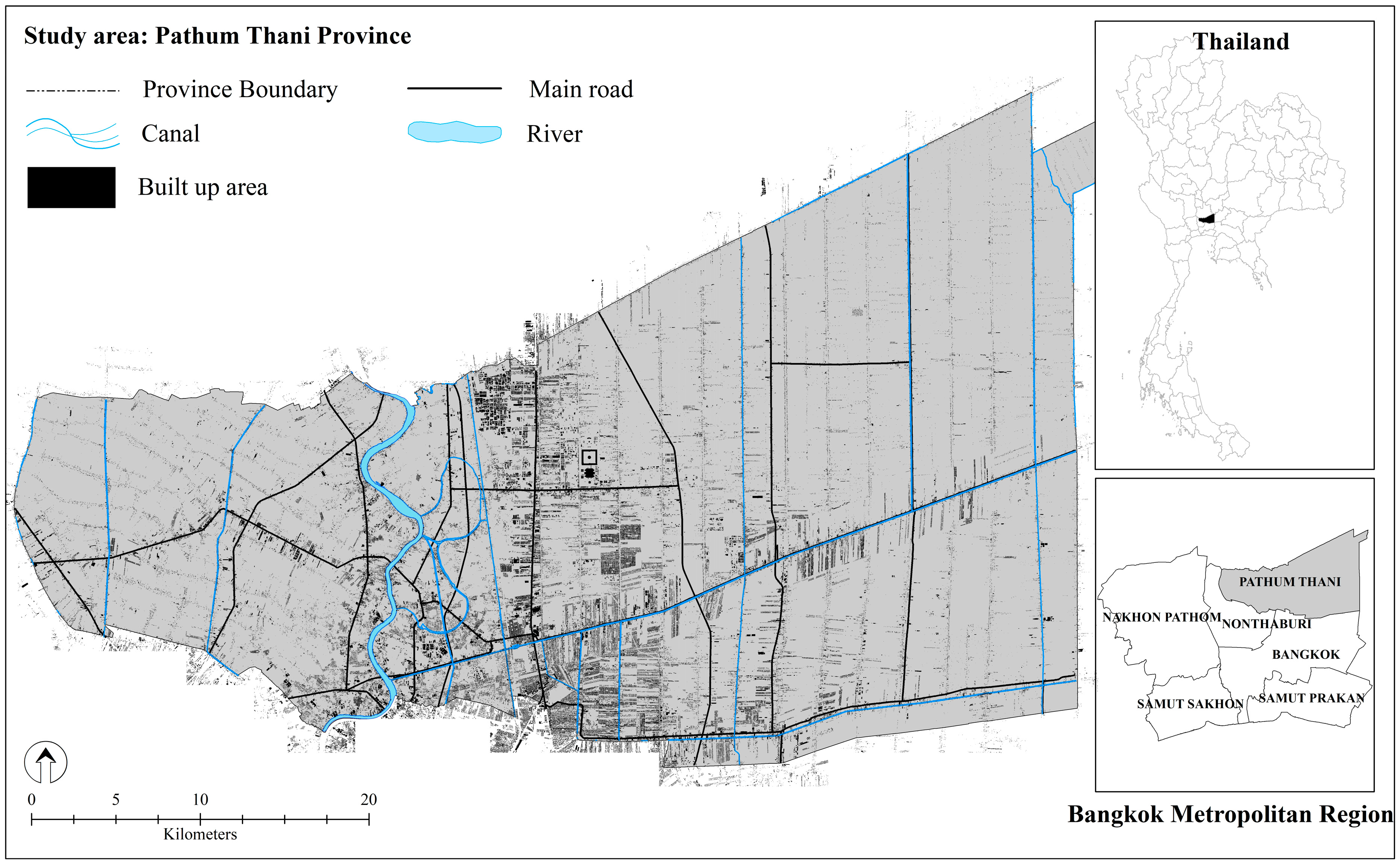
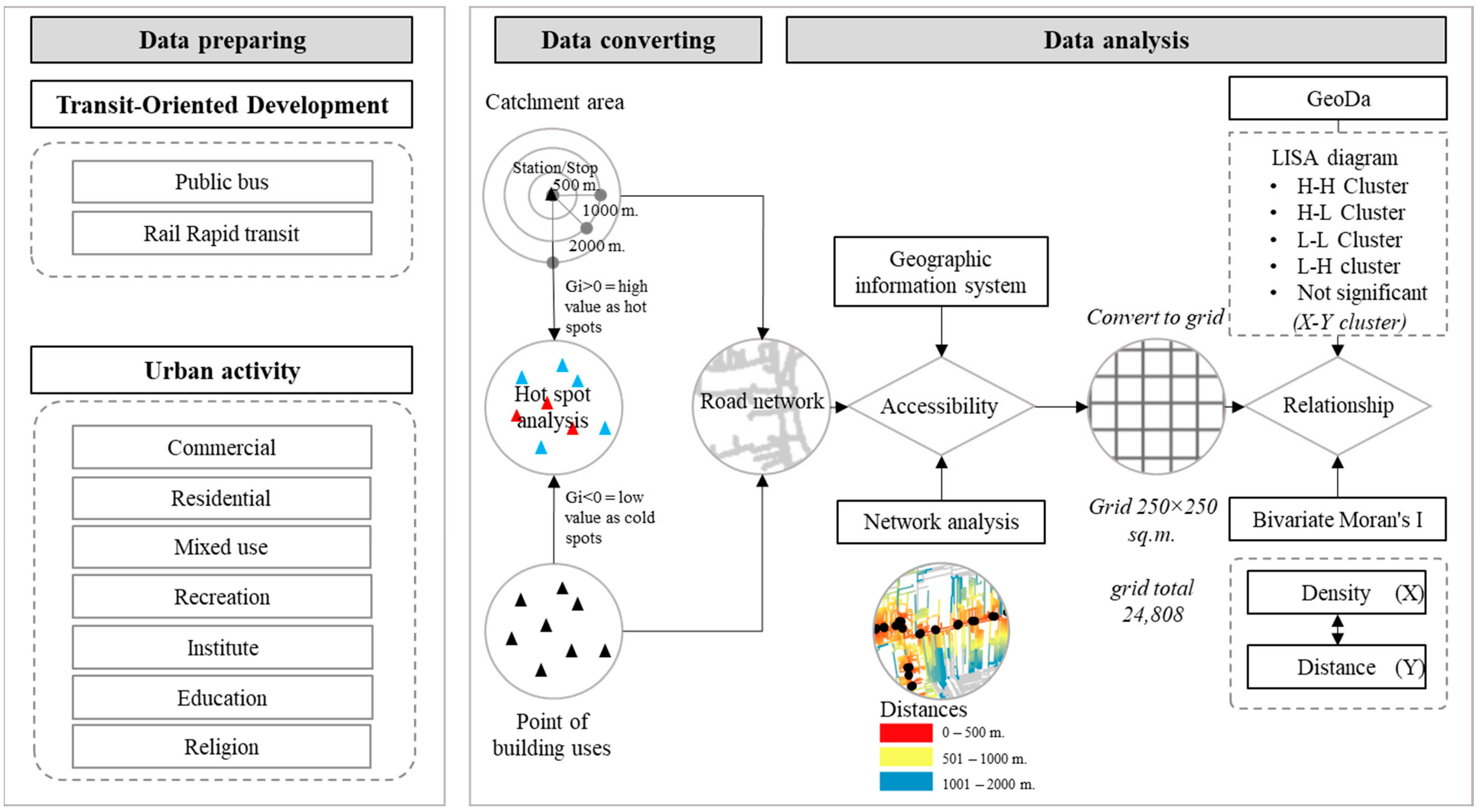
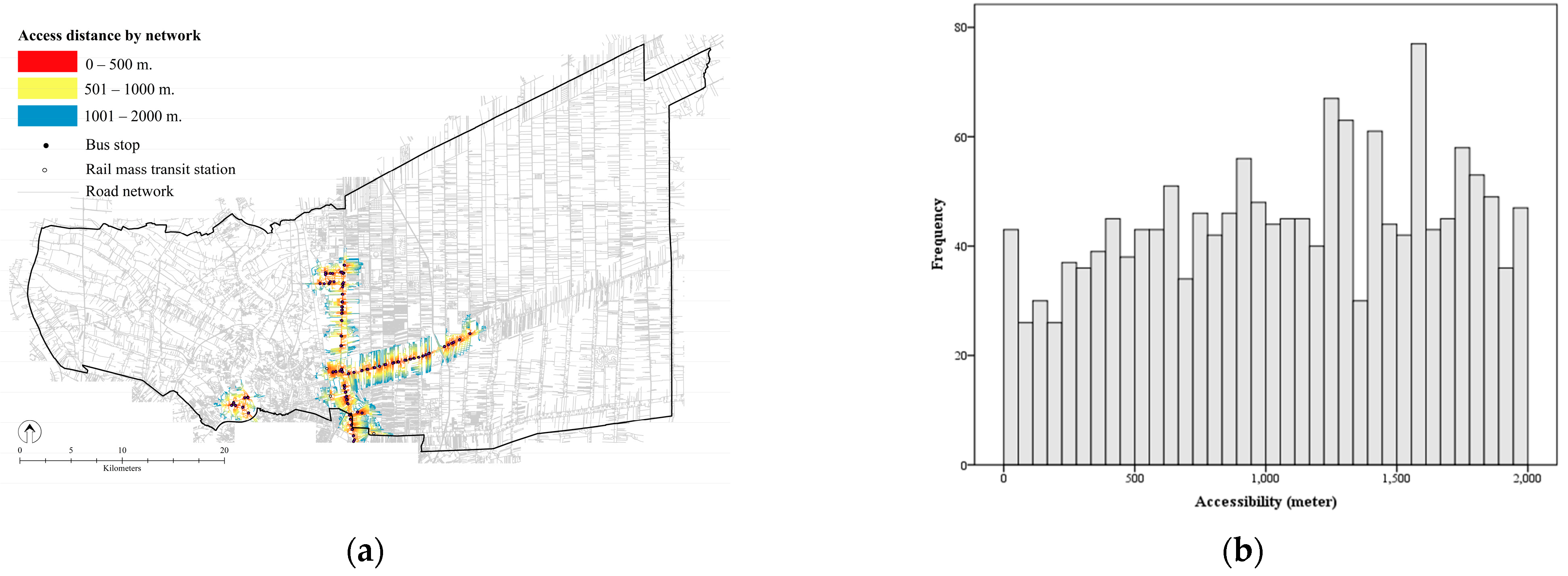

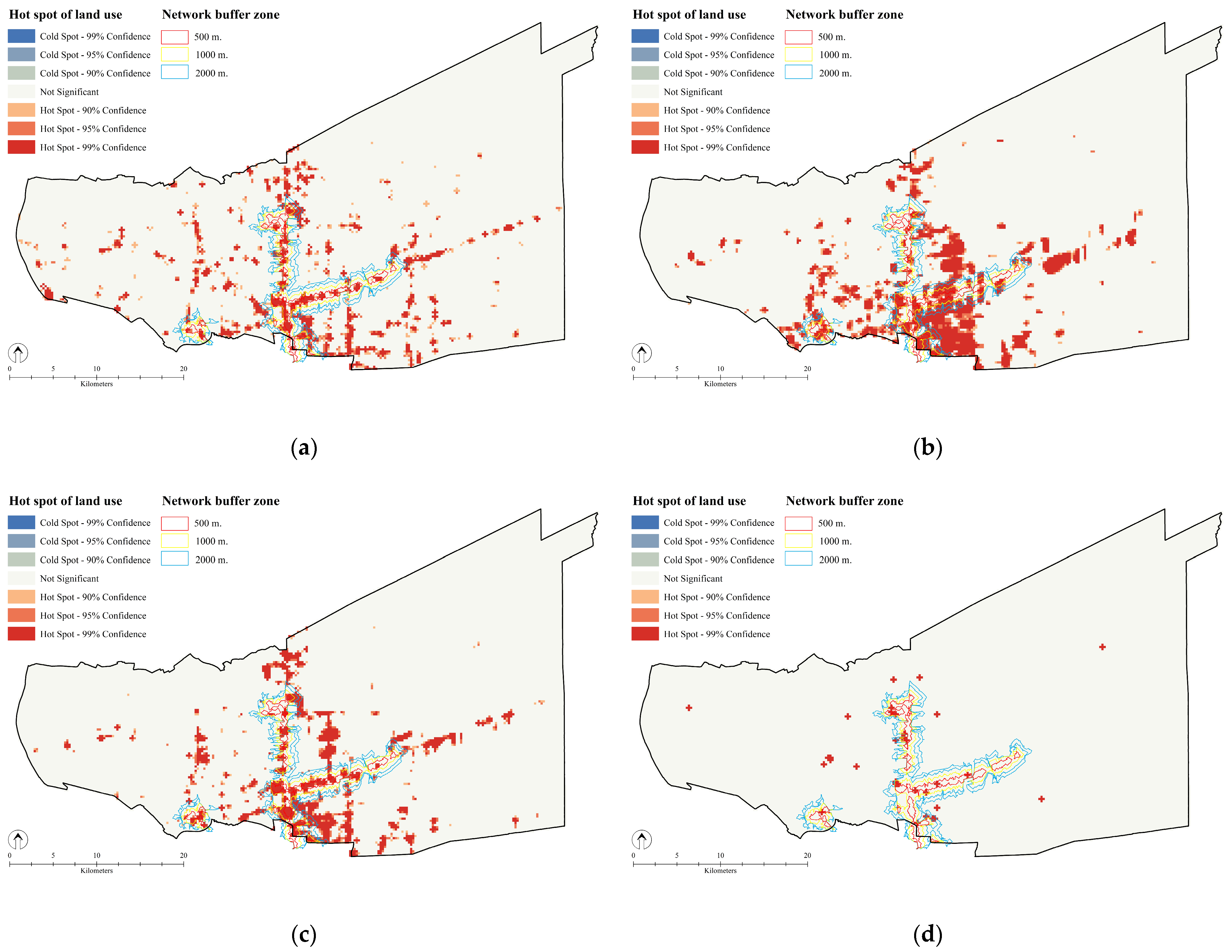


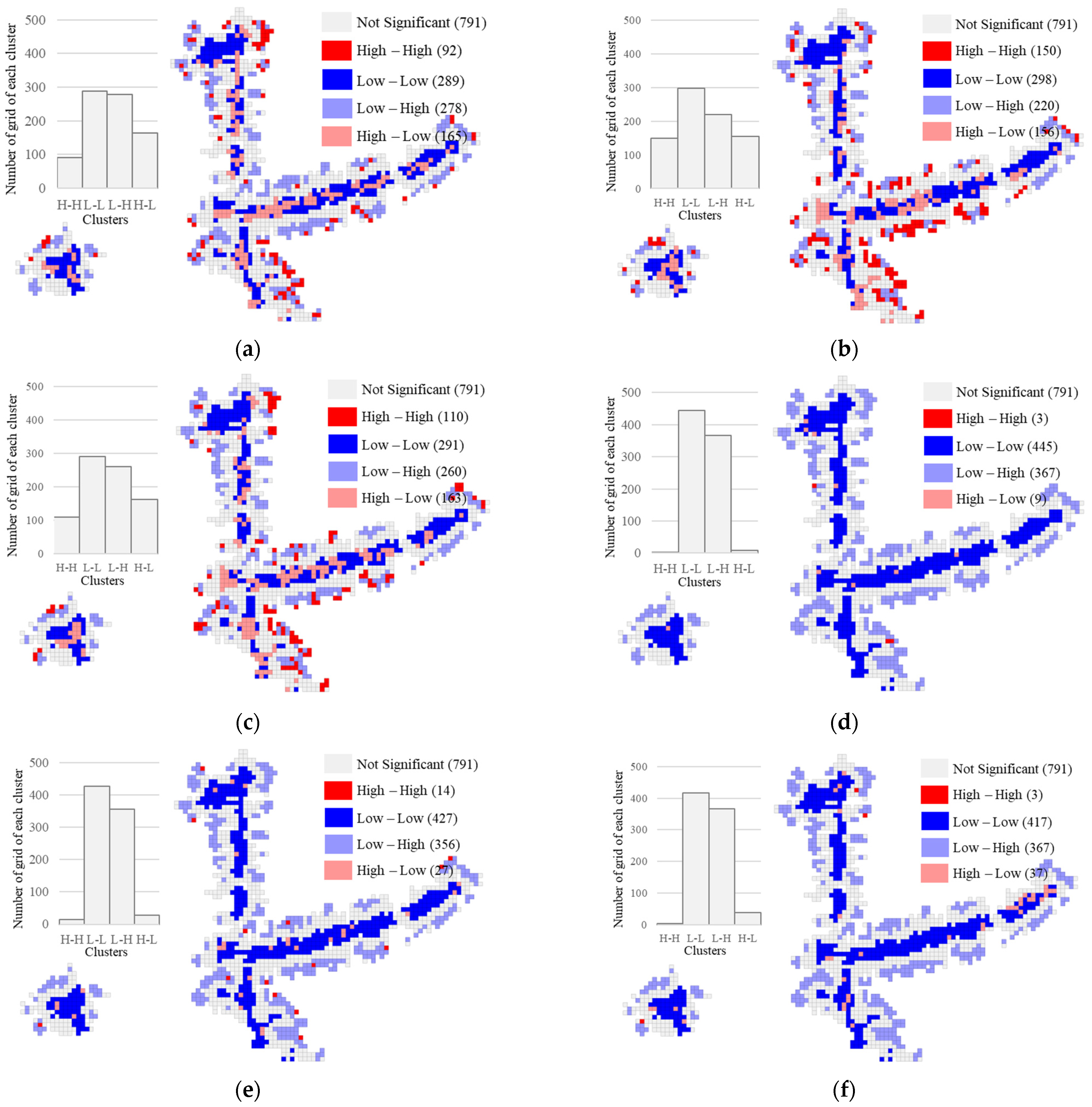
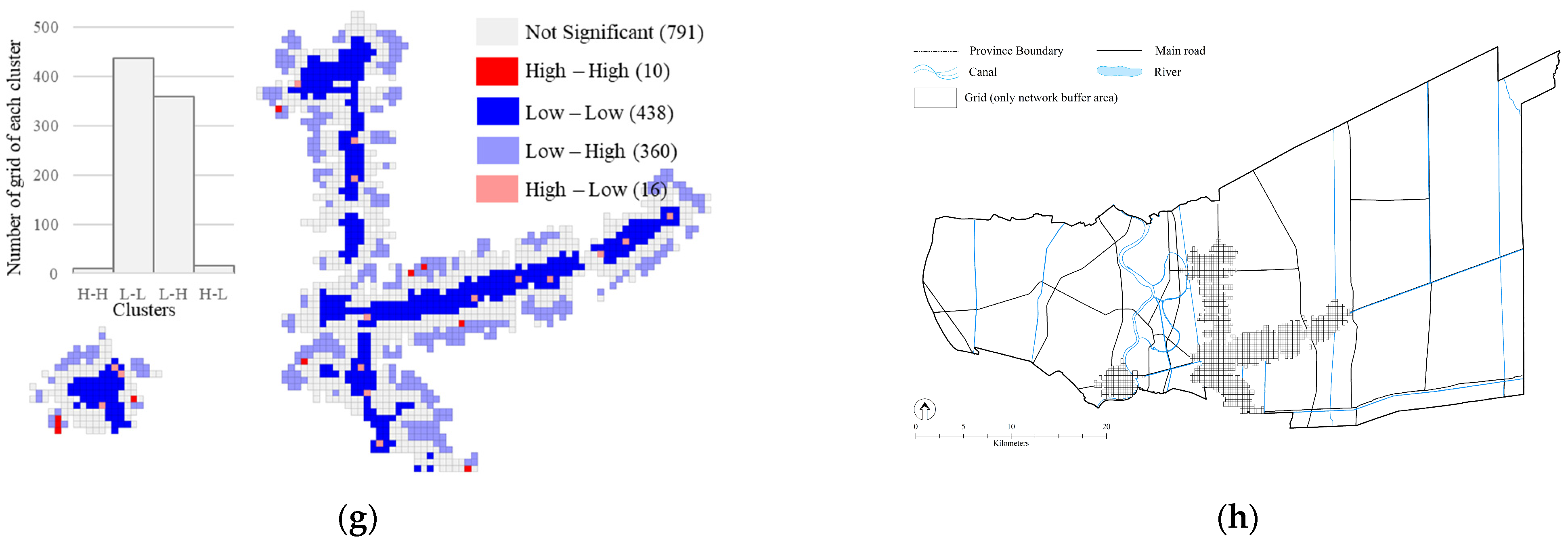
| Urban Activities | Descriptive Statistics | ||
|---|---|---|---|
| Average | SD. | Distribution | |
| Commercial | 0.011 | 0.026 |  |
| Residential | 0.045 | 0.080 |  |
| Mixed use | 0.022 | 0.050 |  |
| Recreation | 0.001 | 0.010 |  |
| Institute | 0.005 | 0.024 |  |
| Education | 0.010 | 0.047 |  |
| Religion | 0.014 | 0.060 |  |
| a. commercial | b. residential | c. mixed use | ||||||
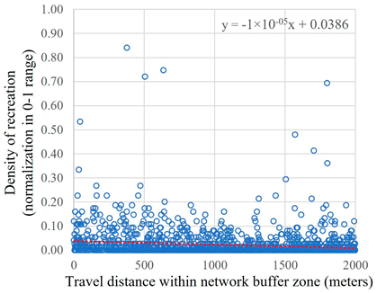 |  |  | ||||||
| R2 | p-value | t-stat | R2 | p-value | t-stat | R2 | p-value | t-stat |
| 0.021 | 0.000 | 12.49 | 0.003 | 0.034 | 14.56 | 0.024 | 0.000 | 15.63 |
| d. recreation | f. education | e. institute | ||||||
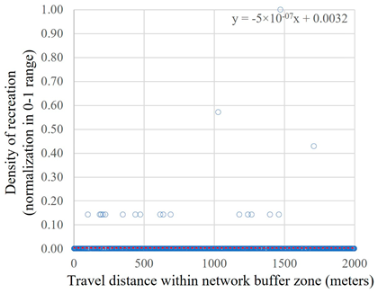 | 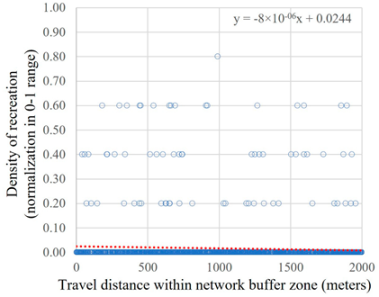 | 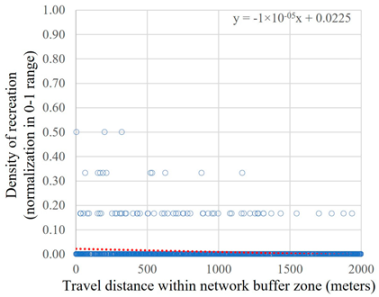 | ||||||
| R2 | p-value | t-stat | R2 | p-value | t-stat | R2 | p-value | t-stat |
| 0.001 | 0.746 | 1.739 | 0.001 | 0.037 | 5.46 | 0.025 | 0.000 | 9.34 |
| g. religion | ||||||||
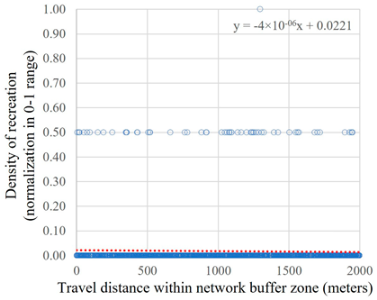 | ||||||||
| R2 | p-value | t-stat | ||||||
| 0.001 | 0.321 | 4.36 | ||||||
Disclaimer/Publisher’s Note: The statements, opinions and data contained in all publications are solely those of the individual author(s) and contributor(s) and not of MDPI and/or the editor(s). MDPI and/or the editor(s) disclaim responsibility for any injury to people or property resulting from any ideas, methods, instructions or products referred to in the content. |
© 2024 by the authors. Licensee MDPI, Basel, Switzerland. This article is an open access article distributed under the terms and conditions of the Creative Commons Attribution (CC BY) license (https://creativecommons.org/licenses/by/4.0/).
Share and Cite
Iamtrakul, P.; Chayphong, S. Exploring Spatial Accessibility to Urban Activities Based on the Transit-Oriented Development Concept in Pathum Thani, Thailand. Sustainability 2024, 16, 2195. https://doi.org/10.3390/su16052195
Iamtrakul P, Chayphong S. Exploring Spatial Accessibility to Urban Activities Based on the Transit-Oriented Development Concept in Pathum Thani, Thailand. Sustainability. 2024; 16(5):2195. https://doi.org/10.3390/su16052195
Chicago/Turabian StyleIamtrakul, Pawinee, and Sararad Chayphong. 2024. "Exploring Spatial Accessibility to Urban Activities Based on the Transit-Oriented Development Concept in Pathum Thani, Thailand" Sustainability 16, no. 5: 2195. https://doi.org/10.3390/su16052195
APA StyleIamtrakul, P., & Chayphong, S. (2024). Exploring Spatial Accessibility to Urban Activities Based on the Transit-Oriented Development Concept in Pathum Thani, Thailand. Sustainability, 16(5), 2195. https://doi.org/10.3390/su16052195






